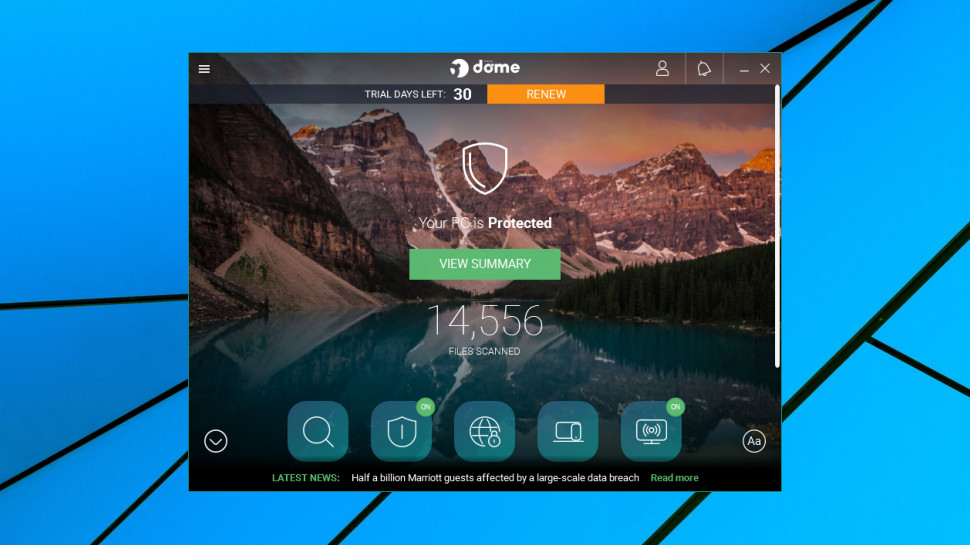TechRadar Verdict
Panda is user-friendly, yet experts will appreciate its advanced system checking features, but below-par lab test results suggest there's more reliable protection elsewhere.
Pros
- +
Unlimited devices per license
- +
Lightweight
- +
Some unusual advanced features
Cons
- -
Inconsistent results from testing labs
- -
Quirky interface won't suit everyone
- -
Doesn't have Panda's anti-ransomware defenses
Why you can trust TechRadar
Panda Security is a Spanish-based company with a strong record of antivirus innovations. From launching daily signature updates in 1998, to introducing behavioral monitoring in 2004 and cloud scanning in 2007, Panda has been involved with a host of technologies we now take for granted.
Panda Dome Essential goes well beyond the basics of real-time antivirus protection with URL filtering, a simple firewall to block network attacks, and even free VPN access. Okay, with no choice of location and a 150MB per day free data allowance you won't be using it for streaming movies or heavy torrenting, but it's fine for emailing on public Wi-Fi hotspots when you're out and about.
The package is reasonably priced at £26.24 ($34) for a one-year license, especially as you're covered for unlimited Windows, Mac and Android devices. As usual, the small print qualifies that 'unlimited' promise somewhat, saying that it's for 'one customer in one household only' and is 'subject to limitations on reasonable home use.' But as long as you're not trying to cheat the system and cover every PC in your entire office, Panda is unlikely to complain.
If Dome Essential isn't powerful enough for you, opting for the $46 Dome Advanced gets you parental controls, additional layers of ransomware and 'advanced threats protection', and identity protection while banking and shopping online.
The next step up, Dome Complete, adds encryption, system clean-up tools and a password manager for $69, while the $116 Dome Premium gets you unlimited VPN access to all locations, and unlimited premium technical support.
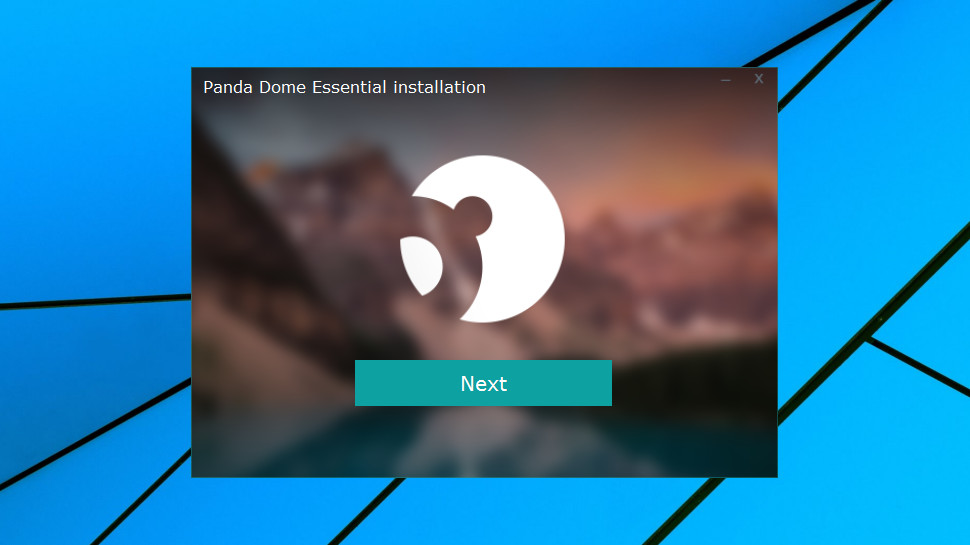
Setup
Panda Dome Essential has a 30-day trial available on the website, and we found, downloaded and launched the build in a few seconds.
The installer is a little more intrusive than expected, and by default it changes both your search provider and home page to try and keep you safe. That's a couple of steps too far, for us, but both options are clearly visible within the installer and you can turn them off immediately.
Once setup was complete, Dome Essential asked us to register the program by providing our email address. We prefer antivirus which allows us to stay anonymous, but many competitors do much the same, and at least we didn't have to provide any payment details.
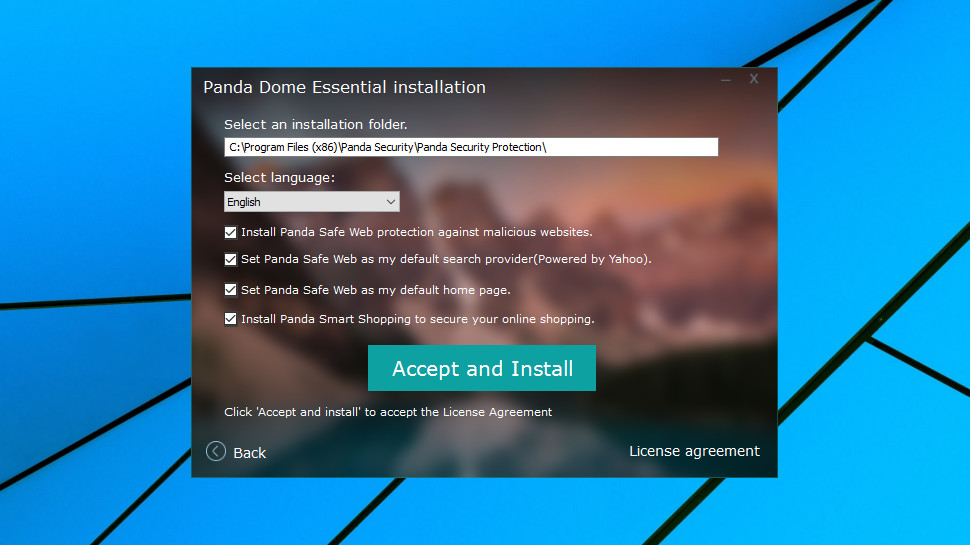
Installation was relatively speedy, with no complaints about 'incompatible' software or other hassles. There was a short delay while Dome Essential ran a quick initial scan, but the main program console then appeared and was ready for use.
Panda has always claimed to be one of the most lightweight antivirus apps around, so we were interested to see how it behaved. Dome Essential added four core background processes to our test system, a little more than usual, but these typically consumed a minimal 20-50MB RAM during normal PC use. We've seen some competitors grab 10 times as much.
Checking Panda's installed files revealed one possible explanation – they took up just 124MB – but there were some oddities, too. Several of the files were unsigned, both third-party code and a few of Panda's own, making them a little harder to authenticate. That's a technical detail rather than a significant security flaw, but when several files have a description of 'TODO: <File description>', that might show a certain lack of attention to detail.

Features
Panda Dome Essential has an eye-catching interface which replaces the usual dull grey background with an appealing wallpaper image. You can switch this to one of several other images, or even have the program cycle through them. This isn't something we would normally look for in an antivirus app, but there's no doubt it adds a lot of visual appeal.
This approach does bring some practical issues, though. The interface leaves a lot of space at the top of the window to enable viewing the image, but because of that, there's only room for a single row of five buttons at the bottom of the screen. There are another two rows of buttons below that, but you must scroll down to see them.
The most important functions are on the top row, fortunately, so this may not slow you down very much. To launch a scan, for instance, you just click the Scan button top-left, choose the scan type (Critical Areas, Full or Custom Scan) and wait for the results. It's all very simple.
Although the regular scan buttons give you almost no control over how your system is checked, the Scheduled Scan feature is a little smarter. You can define the drives and folders to scan, for example, exclude particular locations and customize how the scan works in a few ways (decide whether or not to scan archives, and choose which types of threats to detect: virus, spyware, hacking tools, potentially unwanted programs and more). This is useful, although only a tiny, tiny fraction of the power you'll see from providers such as Avast and Avira.
Scan times are only average, at least initially, so for example even the fastest Critical Areas scan took four minutes to check our test system. But effective optimization sees this drop over time, and our second scan took barely two minutes.
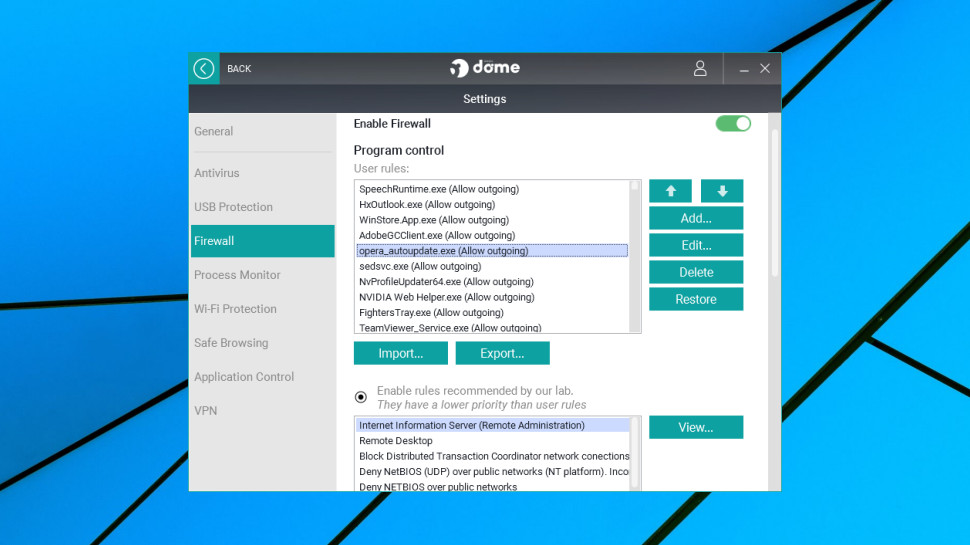
The Dome Essential firewall does its best to keep life simple, with a basic opening screen which just asks you to choose your current Wi-Fi location, from Home, Work and Public Place. But if you know what you're doing, heading off to Settings > Firewall enables defining its operating rules, and provides no less than 18 expert-level intrusion prevention settings relating to port scans, ping handling, flooding and more. No idea what these are? No problem, they have sensible default settings, so networking newbies can safely ignore them entirely.
A handy Process Monitor displays running processes, highlighting any that are accessing the internet and warning you of potential threats. That's all very straightforward for beginners, but again, real power is only a click or two away.
The full Process Monitor report lists the name of each process, when it was detected and last scanned, where it was downloaded from (if appropriate), how many HTTP connections it has made, and allows you to view whatever resources it was trying to access (www.badapp.com/danger.exe – or whatever it might be).
Panda's URL filtering is relatively basic. It blocked some dangerous links, though marginally less than average, and there's no way to whitelist any URLs which might be flagged in error.

The VPN is probably the most surprising extra, connecting you to your nearest server in a couple of clicks. We got speeds of close to 60Mbps on our test system, similar to what we would expect from any commercial VPN.
The free version only offers a data allowance of 150MB per day, making it useless for all but the most lightweight of applications, although you might be able to squeeze a little more out of the service, if you're lucky. (We tried running several parallel downloads and managed to use up 223MB before Dome Essential noticed).
There's a welcome bonus to create a bootable USB rescue drive, which may help remove malware that the regular package can't reach. Other features include a software whitelisting system to take full control over what runs on your PC, a virtual keyboard to protect against keyloggers, a monitor which can raise alerts if you connect to insecure Wi-Fi networks, and an option to ‘vaccinate’ USB keys to reduce the chance of infection by autorun viruses.
Put it all together and Panda Dome Essential has a lot of interesting and genuinely useful features. But they're still not quite as capable as a competitor such as Bitdefender Antivirus Plus, where you'll get more relevant and configurable extras such as industrial-strength banking protection, vulnerability checking, social network monitoring and a password manager.
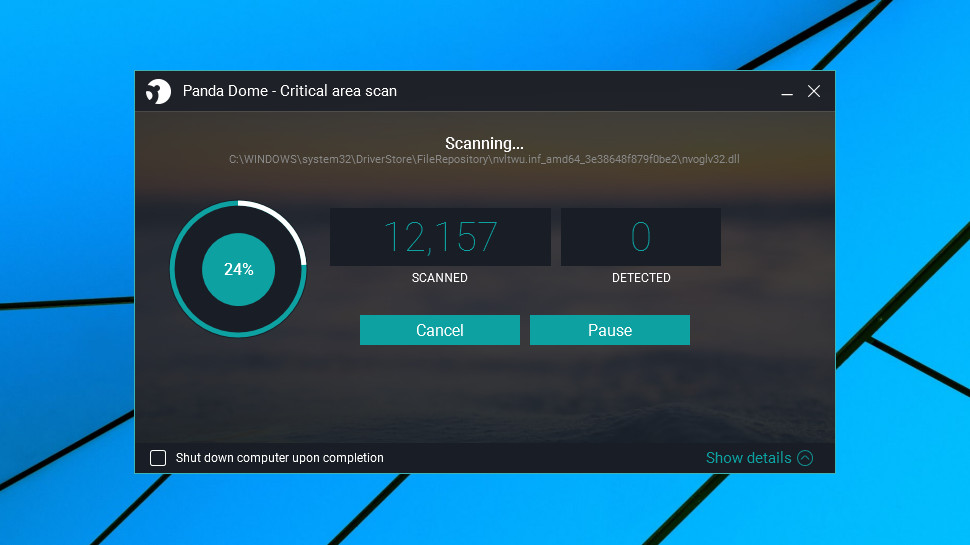
Protection
We carry out our own malware detection tests as a part of every review, but we also check how each vendor is scoring with the big independent testing labs to fully gauge its reliability.
One problem with that approach in this case is that Panda products aren't widely tested right now. The only recent reports we found were at AV-Comparatives, and they can be very inconsistent. For example, Panda came 17th out of 18 in September 2018 with a terrible protection rate of 96.4%, but only a month later it hit 4th with a much more impressive 100% protection.
One-off reports can't tell the whole story, so we looked at AV-Comparatives' February-June 2018 summary of five tests. But that didn't help, unfortunately, with Panda managing a below-par 14th out of 18.

We tried a test of our own, pitting Dome Essential against our own custom ransomware simulator. This is designed to spider through a folder tree, encrypting thousands of user documents, and hopefully triggering an antivirus alert.
Dome Essential paid no attention at all to our simulator, unfortunately, allowing it to destroy every one of our sample documents. That's a little disappointing, but we don't penalize an antivirus too much for failing this test. Our simulator isn't real malware and we can't be entirely sure why Panda missed it.
Panda says itself that Dome Essential doesn't include its specialist protection for ransomware and other 'advanced threats'. To get that, you must upgrade to the more powerful Dome Advanced.
There was finally some good news in PassMark's report on the performance impact of security software. This measures how antivirus packages slow down various common PC tasks, and Panda scored a creditable third out of 14 contenders (only Norton and ESET performed better).
Final verdict
Panda Dome Essential is a likeable product which is easy-to-use and includes some genuinely valuable extras, especially for experts, but it still can't quite match the power, features and accuracy of the market leaders.
- We've also highlighted the best antivirus software in this roundup

Mike is a lead security reviewer at Future, where he stress-tests VPNs, antivirus and more to find out which services are sure to keep you safe, and which are best avoided. Mike began his career as a lead software developer in the engineering world, where his creations were used by big-name companies from Rolls Royce to British Nuclear Fuels and British Aerospace. The early PC viruses caught Mike's attention, and he developed an interest in analyzing malware, and learning the low-level technical details of how Windows and network security work under the hood.
